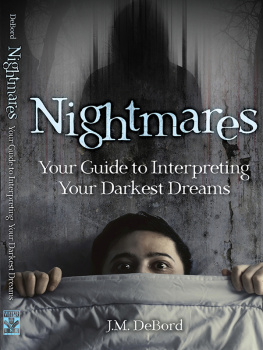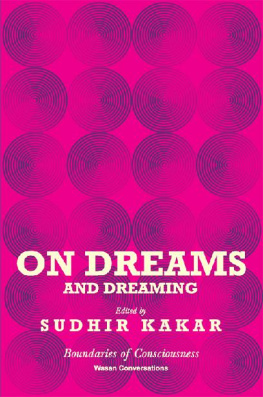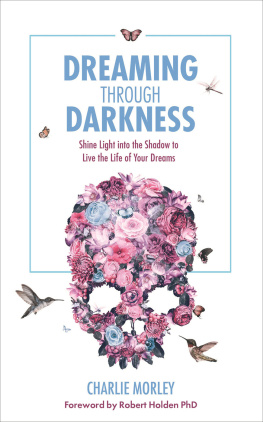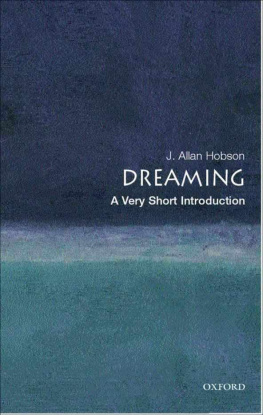Stase Michaels - Nightmares: The Dark Side of Dreams and Dreaming
Here you can read online Stase Michaels - Nightmares: The Dark Side of Dreams and Dreaming full text of the book (entire story) in english for free. Download pdf and epub, get meaning, cover and reviews about this ebook. genre: Science fiction. Description of the work, (preface) as well as reviews are available. Best literature library LitArk.com created for fans of good reading and offers a wide selection of genres:
Romance novel
Science fiction
Adventure
Detective
Science
History
Home and family
Prose
Art
Politics
Computer
Non-fiction
Religion
Business
Children
Humor
Choose a favorite category and find really read worthwhile books. Enjoy immersion in the world of imagination, feel the emotions of the characters or learn something new for yourself, make an fascinating discovery.

- Book:Nightmares: The Dark Side of Dreams and Dreaming
- Author:
- Genre:
- Rating:3 / 5
- Favourites:Add to favourites
- Your mark:
- 60
- 1
- 2
- 3
- 4
- 5
Nightmares: The Dark Side of Dreams and Dreaming: summary, description and annotation
We offer to read an annotation, description, summary or preface (depends on what the author of the book "Nightmares: The Dark Side of Dreams and Dreaming" wrote himself). If you haven't found the necessary information about the book — write in the comments, we will try to find it.
Nightmares: The Dark Side of Dreams and Dreaming — read online for free the complete book (whole text) full work
Below is the text of the book, divided by pages. System saving the place of the last page read, allows you to conveniently read the book "Nightmares: The Dark Side of Dreams and Dreaming" online for free, without having to search again every time where you left off. Put a bookmark, and you can go to the page where you finished reading at any time.
Font size:
Interval:
Bookmark:
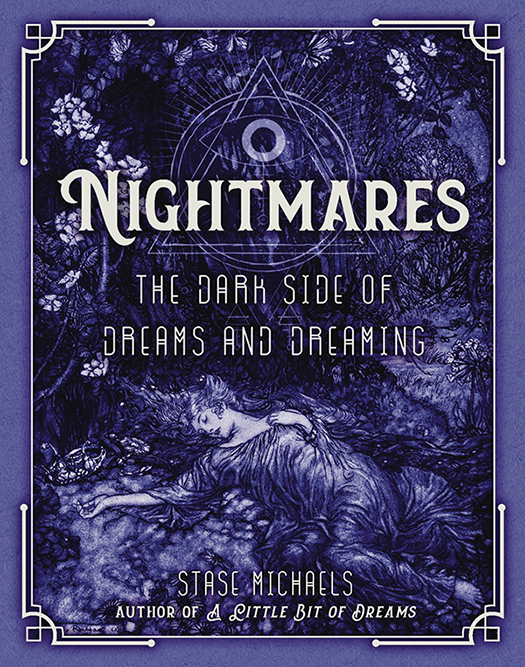
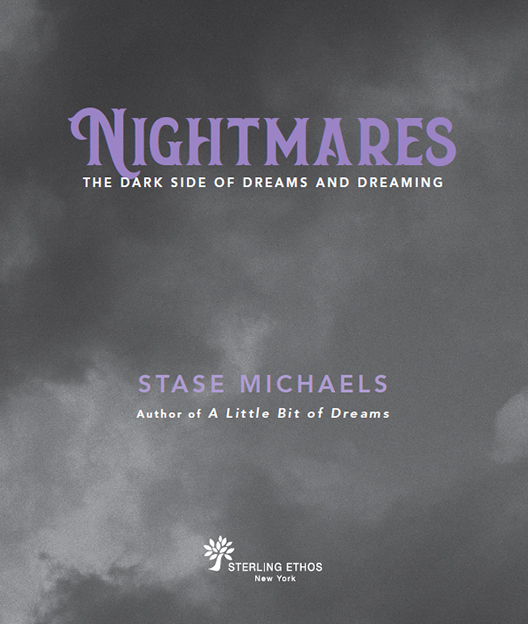

STERLING ETHOS and the distinctive Sterling Ethos logo are registered trademarks of Sterling Publishing Co., Inc.
Text 2018 Stase Michaels
Cover 2018 Sterling Publishing Co., Inc.
All rights reserved. No part of this publication may be reproduced, stored in a retrieval system, or transmitted in any form or by any means (including electronic, mechanical, photocopying, recording, or otherwise) without prior written permission from the publisher.
ISBN 978-1-4549-2738-9
For information about custom editions, special sales, and premium and corporate purchases, please contact Sterling Special Sales at 800-805-5489 or .
Cover design by Igor Satanovsky
Interior design by Christine Heun
sterlingpublishing.com
For image credits, see


When you get a text message or phone call from someone you love, you trust the source and instantly pick up. A nightmare has a bad rap as a frightening message that many run from. Not so! Even when a communication is scary, ditch preconceptions and welcome a nightmare as a conversation you want to have with a best friendthe wiser part of you.
Which of these statements about nightmares is true?
A. When you dream about someone who died, it can be an actual visit.
B. A nightmare about a disaster can be a true warning.
C. Nightmares have a hidden, yet constructive, message.
D. All of the above.
As the following chapters explain, the answer is (D): all of the above statements can be true. Dreams about the dead are often actual visits from a loved one who has passed on. In terms of warnings, dreams have warned many about an upcoming disaster or challenge. And like all dreams, a nightmare can bring helpif you unravel the map that points to the treasured message. Hint: Getting the message is easy. Chapter Three outlines a fast and easy way to find the meaning of a dream, including nightmares, with more hints scattered throughout the book.
Which of these statements about nightmares is false?
A. If you feel terrified and see yourself falling in a dream, you can die.
B. If you dream about a coffin, it means that someone will die.
C. If someone sleepwalks during a nightmare, they can harm someone.
D. All of the above.
The answer is a resounding (D): all of the above statements are false. The old wives tale that you can die if you dream that you are falling is a crock. There is no such thing as a symbol that always means the same thing for everyone: falling is a metaphor for losing control or feeling as if life is not on firm ground; like all symbols, it has a different meaning for different dreamers. This basic fact about symbols also rules out the misconception that dreams about a coffin are a sign that someone will die.
On to the sleepwalking statement. Research shows that while you dream, the large muscles of your body that control the arms and legs are paralyzed. The part of the brain that controls gross movements is on hold as you dream, so you cannot sleepwalk during a nightmare. Brain wave patterns during sleep show that you dream during Stage 1 of normal sleep, the level that is closest to being awake, so you dream when you are almost awake! Sleepwalking, on the other hand, happens during a deep sleep stage. A sleepwalker can experience random images, even scary ones, but a sleepwalker is not experiencing a full dream or nightmare. That is why, even during a blood-curdling nightmare, the potential to harm someone is extremely low, or negligible.
Understanding a nightmare is like attending the best Halloween costume party ever. When you arrive, your favorite TV and movie stars are waiting to greet you. All the guests race through a terrifying haunted house complete with fog, ghosts, ghouls, and gore. Fueled by adrenaline, you end up on a dimly lit dance floor, screamingyet entertained. As you catch your breath, you realize that everything you just experienced was an entertaining faade that also boggled your mind. Even though it was scary, it made you let loose, transform, and experience the moment in a new way. Comparing nightmares to a Halloween party may sound crazy, yet it parallels what is true. Most of the time, a nightmare is a regular dream dressed up in a scary costume. Of course, there are exceptions. There are always exceptions. More on that later.
How does a nightmare differ from a dream? A nightmare is differentyet the same. Dreams and nightmares both bring a message that can steer you past a challenge, provide insights about people, and give hints about how to resolve a problem. The main difference is that a nightmare is scary.
So the real question becomes: Why does a dream turn into a nightmare, and how does it happen? The quick answer describes a domino effect that goes like this: Anxiety makes you afraid. You fear the unknown, you resist what you fear, and you back away from what you do not want to confront. Fear distorts what you see and feel, including dream images. Suppose you see a dog walking down a dark street at midnight; as it approaches, dark shadows make it look terrifying, even if the pooch is friendly. Fear distorts a dream message, forcing dream characters and objects to hide behind scary costumes.
A nightmare also differs from a dream in power and energy. Emotionally, a dream can feel like a gentle rain or downpour; a nightmare lashes out with the power of a thunderstorm or hurricane that will not be ignored. A dream is a polite invitation. A nightmare pounds at your door, screaming, until you answer.
Like most dreams, nightmares are messages from your wiser, inner self, as a shout about something urgent that needs your attention. For believers, on a rare occasion a nightmare can be a heads-up from a guardian angel or a warning from the Divine itself. Joseph received a dream advising him to leave Bethlehem and flee to Egypt with Mary and Jesus, to avoid Herods sword. Josephs dream happened centuries ago as a notable event in Christian history, yet many still experience dream warnings. For those who are curious about how a dream happens, later sections provide a glimpse into the mechanics of a dream.
Most nightmares target a dreamers anxieties, as a helping hand from the psyche. Sometimes the helping hand arrives as a nightmare. Why? Like a kick in the pants, sometimes a good scare can trigger a positive reaction. A man dreams that everyone except him gets promoted. The dream terrifies him, yet it also spurs him to get off his butt and take courses to improve his career skills. A scary dream can mirror a clash in a relationship, like the woman who dreams that a dog bites her hand. Her dream parallels a boyfriends verbal put-downs: when she draws a line in the sand and tells him to back off, the nightmares disappear. A senior approaching retirement has nightmares about being stranded on a boat in the middle the ocean, as a fear of not being able to cope on a retirement income. It motivates him to make a new financial plan, for added security. Yes, terrifying dreams throw you into a maze of uncertainty. But they also include a message that shows the way out; and if you look closely, you can find that arrow.
Font size:
Interval:
Bookmark:
Similar books «Nightmares: The Dark Side of Dreams and Dreaming»
Look at similar books to Nightmares: The Dark Side of Dreams and Dreaming. We have selected literature similar in name and meaning in the hope of providing readers with more options to find new, interesting, not yet read works.
Discussion, reviews of the book Nightmares: The Dark Side of Dreams and Dreaming and just readers' own opinions. Leave your comments, write what you think about the work, its meaning or the main characters. Specify what exactly you liked and what you didn't like, and why you think so.


